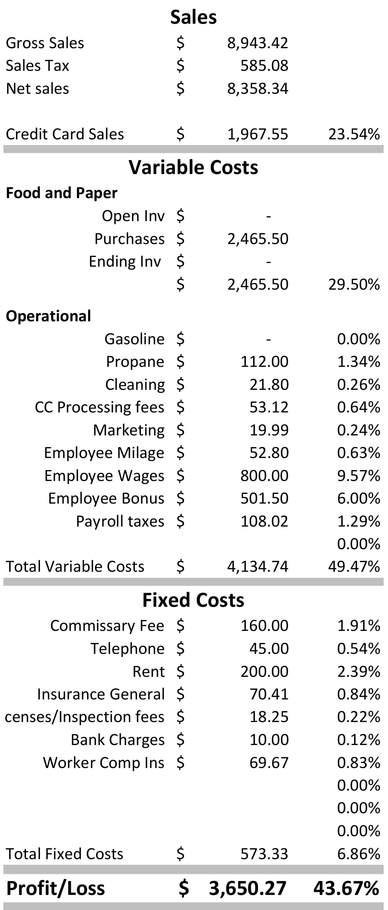 One of many pathogens found in improperly cooked foods. One of many pathogens found in improperly cooked foods. “Pride is pride not because it hates being wrong, but because it loves being wrong: To hate being wrong is to change your opinion when you are proven wrong; whereas pride, even when proven wrong, decides to go on being wrong.” I am a part of many vending related Facebook groups. Some I just read and rarely comment. Others I comment often trying to clarify answers and actually help people learn and better their business. I even had one group ban me when I asked in a private message why they allowed illegal information encouraging tax fraud to remain unchallenged. They claim to be an “academy” for food vendors but if you won’t delete or correct illegal information , the only thing you are an “academy” for is failure. This weekend I got into a debate over whether a food certification is required in certain states. Some states like Florida actually ask for the certification on their inspection form, making it clear the certification is required. Other states are very ambiguous as to whether the certification is required. One person quoted me an email from her inspector stating the certification is not required. Leaving that statement as absolute proof you need not be certified. EXCEPT while the certification is not required the very first thing on the inspection sheet for that state asks: “Person in charge present, demonstrates knowledge, and performs duties”. How do you “demonstrate knowledge”? According to every FDA Code starting in 1997 (find them all here) and every code year including 2017 is a passage containing this:
And then it lists 17 different ways to demonstrate knowledge. This is the 1997 version. In 2017 that passage is worded:
And it goes on to list 17 areas for the questions. The inspector can ask as many as they want until satisfied the person in charge possesses enough knowledge to safely sell food. Understand 48 out of 50 states base their code on the FDA model code(link). The only difference is which year they use. NY and CT are the outliers using their own codes. CT does require what they call a Qualified Food Operator and NY code says this:
Demonstrating knowledge is done by one of 3 ways as noted in the FDA Codes:
Asking your sanitarian “Does our state require Serv-Safe?” could get you an incomplete answer of “No, we do not require Serv-Safe”. Making you think “Oh yeah! No test for me!”, when the actual question should have been “Where do I get the training needed to meet knowledge demonstration requirement in our state’s food code?” That answer would be: “Take one of the courses and tests approved by our state and you can find those on our website.” The point here is asking the correct question gets you the right information. Understand Serv-Safe is generically used to refer to training, testing and certification for becoming a Certified Food Manager. Your state may only accept a certification they offer, or they may accept several different companies that offer training and testing. However, rest assured you need training or your food vendor career will be a short one.
0 Comments
 A single cart or trailer allows a certain amount of freedom and financial stability if ran properly, but the income is capped by the owner’s abilities and unfortunately, the weather. How can a vendor hedge against weather, injury or sickness preventing them from opening? Increase the number of income streams! If one location produces $50,000 after tax income annually, work towards a second doing the same sales volume. Then a third and so on. I know what you are thinking, “how do I staff them?” That’s why I encourage everyone to write procedures and policies in a manual. Now you have the basis for training an employee. I have mentioned a time or two that I am a control freak, so now when I hire an employee I have a complete training guide to follow. This ensures the new hire is up to speed and giving the type of quality and service, my guests expect. An employee requires, at minimum food safety training, (check with your health department for training required for food service employees) as well as training specific to your food recipes and handling guests. Hiring can be difficult for some people. Knowing what to legally ask, how to judge ability from questions or friendliness after the interview, even judging honesty are all difficult and for some folks impossible. As a small business looking to expand that first new hire can literally make or break the expansion dream. If you have never interviewed someone take a class or two on hiring and interviewing practices for your area. Just like the health department rules vary widely from state to state so do employment laws, unemployment taxes, payroll taxes, workers comp insurance and income taxes. Also, you have to pay the employer match for FICA. There are pre-employment tests you can administer as a part of the application process and there are several services offering these tests. Burger King, for example, uses a couple of different test to determine integrity. In practice these tests disqualify more applicants than they approve, but they do show results, so you can decide on whether to interview them or not. Once you have decided on a new hire you will of course have to spend time training them to your standards of quality, service and cleanliness. The more time you spend with an employee the better they will perform when left alone. I encourage you to develop some type of bonus or incentive for the employee so that they will be invested in the success of the cart. Structure the bonus program with several different areas to measure performance. I always work my new location and hire someone for my older locations. This doesn’t task a new employee with trying to build sales all they have to do is maintain what I have developed. Here is my bonus matrix I use when hire employees. A matrix system rewards varying levels of desired performance and is not the typical all or nothing bonus system most restaurant companies offer. Looking at the matrix pictured above, you will notice I reward 5 different areas of performance and offer differing levels of rewards. This cart is open from 11 AM to 2 PM on a beach location. The employee meets me at the commissary at 10 AM, clocks in verifies the inventory and cash with me, and then tows the cart to the beach and is open for business by 11 AM. At 2 PM tear down begins, and the cart is returned to the commissary. We count cash and inventory and the employee clocks out by 3 PM. The wages earned at this point are 5 hours times $10 for a total of $50. Mileage from commissary to beach for me is 6-mile round trip and I pay $0.55 per mile. Making the total compensation per day $53.30. Our goal is to open Thursday to Sunday each week depending on weather, for a total of 16 days average each month. For this example, the employee ran cart turned in these numbers:
I limit my labor costs by doing all the prep work and clean up for all carts as well as inventory purchasing. My employee meets me at the commissary and gathers up the cart and food to transport to the location. They are on the clock and that is why I offer mileage reimbursement (which is based on Google maps listed mileage) and I can verify tardiness as they must meet me at certain time. The mystery shop could happen at any time and the form I use will fail the visit if the cart isn’t open for business on time or is closed early. (The employee must call me to close due to weather) I use friends and regular guests to mystery shop and offer them free food as incentive as well as reimbursing the actual visit cost. You could replace this section with social media reviews. Just come up with a system that could not easily tricked by your employees. Inventory is counted upon return to the commissary and compared to sales reports. Any discrepancy is counted as waste. We then verify sales and reconcile cash to the reports. I use LoyversePOS which provides all the tracking I need as well as security as I can lock employees out of seeing sensitive sales reports. My expectation is the cash matches exactly. If it does not the difference is taken out of the tips jar. We then review sales, food cost and waste. The employee knows where he stands bonus wise and what to do to improve. This entire process takes 15 to 20 minutes and the employee is finished for the day. This system has worked well for me. I don’t do this all year long as my area is very tourist driven. Spring is college kids and I track what college goes on break and when. I know what schools come here and who passes us by. Summer is family time vacation. Once school starts mid-August the prime time is lost, and my additional carts are closed. Fall is slow, and winter is dead between weather and a lack of interest in outdoor activities I may only open 7 to 10 days, if that, each month till March. When I do open it is usually at fairs and flea markets, so I get guaranteed business. When you increase your income your state and federal tax brackets will change. Remember to account for the increased tax liability and make those payments on time! As always seek profession advice concerning your taxes. Below is a P&L showing the profit potential of this system. This sample is set up for a one-month sales period. Look at it this way. If you spend 90 minutes a day prepping, inventorying and cleaning your second cart you just paid yourself over $150 an hour for just that cart. Amazingly enough, a third cart does not add the full 90 minutes to your day as you will just be prepping in bigger quantities and cleaning only a few more pans. Doubling or tripling carts absolutely does not double or triple prep and clean up time.  Of course, you can pay minimum wage or slightly better and keep more profits for yourself. BUT minimum wage only attracts inexperienced or otherwise unskilled applicants. When wages and bonus packages are tied to improving operations and sales the employee has a vested interest in improvement. Remember any bonus system must be attainable and measurable, as well as, reviewed often with the employee. Otherwise they lower their productivity to match their perception of your hourly wage. |
Bill MI have had a passion for helping people since an early age back in rural Kentucky. That passion grew into teaching and training managers and owners how to grow sales, increase profits, and retain guests. You’ll find a ton of information here about improving restaurant and food cart/trailer operations and profits. Got questions? Email me at [email protected] Archives
January 2023
|

 RSS Feed
RSS Feed